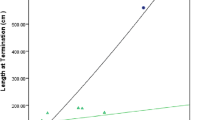Abstract
Purpose
The aim of this study is to determine if prospective determinations of citrulline could be predictive of the bowel adaptation in children with short bowel syndrome (SBS).
Methods
Between March 2005 and March 2010, we prospectively included 28 SBS patients on parenteral nutrition. The citrulline and the enteral intake determinations were scheduled at the inclusion and at 6-month intervals. We assessed the correlation between citrulline and bowel length as well as enteral caloric intake, longitudinal trend of citrulline and association between patients characteristics according to the course of bowel adaptation.
Results
Citrulline significantly correlated with the residual duodenum–jejunum length (r 2 = 0.22, P = 0.0113) and with enteral intake (r 2 = 0.20, P = 0.016 and r 2 = 0.48, P = 0.0001). Baseline citrulline at the cutoff >10 μmol/L and a longitudinal increase >25% provided a weak association with bowel adaptation (likelihood ratio (LR), 2.6 and 2.4, respectively), unlike residual small bowel length ≥20 cm and the presence of >50% of the colon (LR, 10 and 6, respectively).
Conclusions
Citrulline seems to be a powerful biomarker of the intestinal function, showed by the correlation with the residual duodenum–jejunum length and the enteral absorption, but not of its prospective changes during the bowel adaptation process. Future studies may be necessary to confirm this finding.


Similar content being viewed by others
References
Luo M, Fernandez-Estivariz C, Manatunga AK et al (2007) Are plasma citrulline and glutamine biomarkers of intestinal absorptive function in patients with short bowel syndrome? J Parenter Enteral Nutr 31:1–7
Rhoads JM, Plunkett E, Galanko J et al (2005) Serum citrulline levels correlate with enteral tolerance and bowel length in infants with short bowel syndrome. J Pediatr 146:542–547
Fitzgibbons S, Ching YA, Valim C et al (2009) Relationship between serum citrulline levels and progression to parenteral nutrition independence in children with short bowel syndrome. J Pediatr Surg 44:928–932
Crenn P, Coudray-Lucas C, Thuillier F et al (2000) Postabsorptive plasma citrulline concentration is a marker of absorptive enterocyte mass and intestinal failure in humans. Gastroenterology 119:1496–1505
Crenn P, Vahedi K, Lavergne-Slove A et al (2003) Plasma citrulline: a marker of enterocyte mass in villous atrophy-associated small bowel disease. Gastroenterology 124:1210–1219
Bailly-Botuha C, Colomb V, Thioulouse E et al (2009) Plasma citrulline concentration reflects enterocyte mass in children with short bowel syndrome. Ped Res 65:559–563
Crenn P, Messing B, Cynober L (2008) Citrulline as a biomarker of intestinal failure due to enterocyte mass reduction. Clin Nutr 27:328–339
Crenn P, Coudray-Lucas C, Cynober L et al (1998) Post-absorptive plasma citrulline concentration: a marker of intestinal failure in humans. Transplant Proc 30:25–28
Jianfeng G, Weiming Z, Ning L et al (2005) Serum citrulline is a simple quantitative marker for small intestinal enterocytes mass and absorption function in short bowel patients. J Surg Res 127:177–182
Wakabayashi Y, Iwashima A, Yamada E et al (1991) Enzymological evidence for the indispensability of small intestine in the synthesis of arginine from glutamate. II. N-acetylglutamate synthase. Arch Biochem Biophys 291:9–14
Rabier D, Kamoun P (1995) Metabolism of citrulline in man. Amino Acids 9:299–316
Largilliere C, Houssin D, Gottrand F et al (1989) Liver transplantation for ornithine transcarbamylase deficiency in a girl. J Pediatr 115:415–417
Curis E, Nicolis I, Moinard C et al (2005) Almost all about citrulline in mammals. Amino Acids 29:177–205
Wilmore DW (1999) Growth factors and nutrients in the short bowel syndrome. J Parenter Enteral Nutr 23:S117–S120
Goday PS (2009) Short bowel syndrome: how short is too short? Clin Perinatol 36:101–110
Quiros-Tejera RE, Ament ME, Reyen L et al (2004) Long-term parenteral nutritional support and intestinal adaptation in children with short bowel syndrome: a 25-year experience. J Pediatr 145:157–163
Jeppesen PB, Mortensen PB (1998) The influence of e apreserved colon on the absorption of medium chain fat in patients with small bowel resection. Gut 43:478–483
Goulet OJ, Revillon Y, Jan D et al (1991) Neonatal short bowel syndrome. J Pediatr 119:18–23
Georgeson KE, Breaux CW Jr (1992) Outcome and intestinal adaptation in neonatal short-bowel syndrome. J Pediatr Surg 27:344–348
Goulet O (1998) Short bowel syndrome in pediatric patients. Nutrition 14:784–787
Sondheimer JM, Cadnapaphornchai M, Sontag M et al (1998) Predicting the duration of dependence on parenteral nutrition after neonatal intestinal resection. J Pediatr 132:80–84
Peters JH, Wierdsma NJ, Teerlink T et al (2008) The citrulline generation test: proposal for a new enterocyte function test. Aliment Pharmacol Ther 27:1300–1310
Acknowledgments
This study was supported by a grant from the Department of Public Health.
Conflicts of interest
None.
Author information
Authors and Affiliations
Corresponding author
Rights and permissions
About this article
Cite this article
Diamanti, A., Panetta, F., Gandullia, P. et al. Plasma citrulline as marker of bowel adaptation in children with short bowel syndrome. Langenbecks Arch Surg 396, 1041–1046 (2011). https://doi.org/10.1007/s00423-011-0813-8
Received:
Accepted:
Published:
Issue Date:
DOI: https://doi.org/10.1007/s00423-011-0813-8




